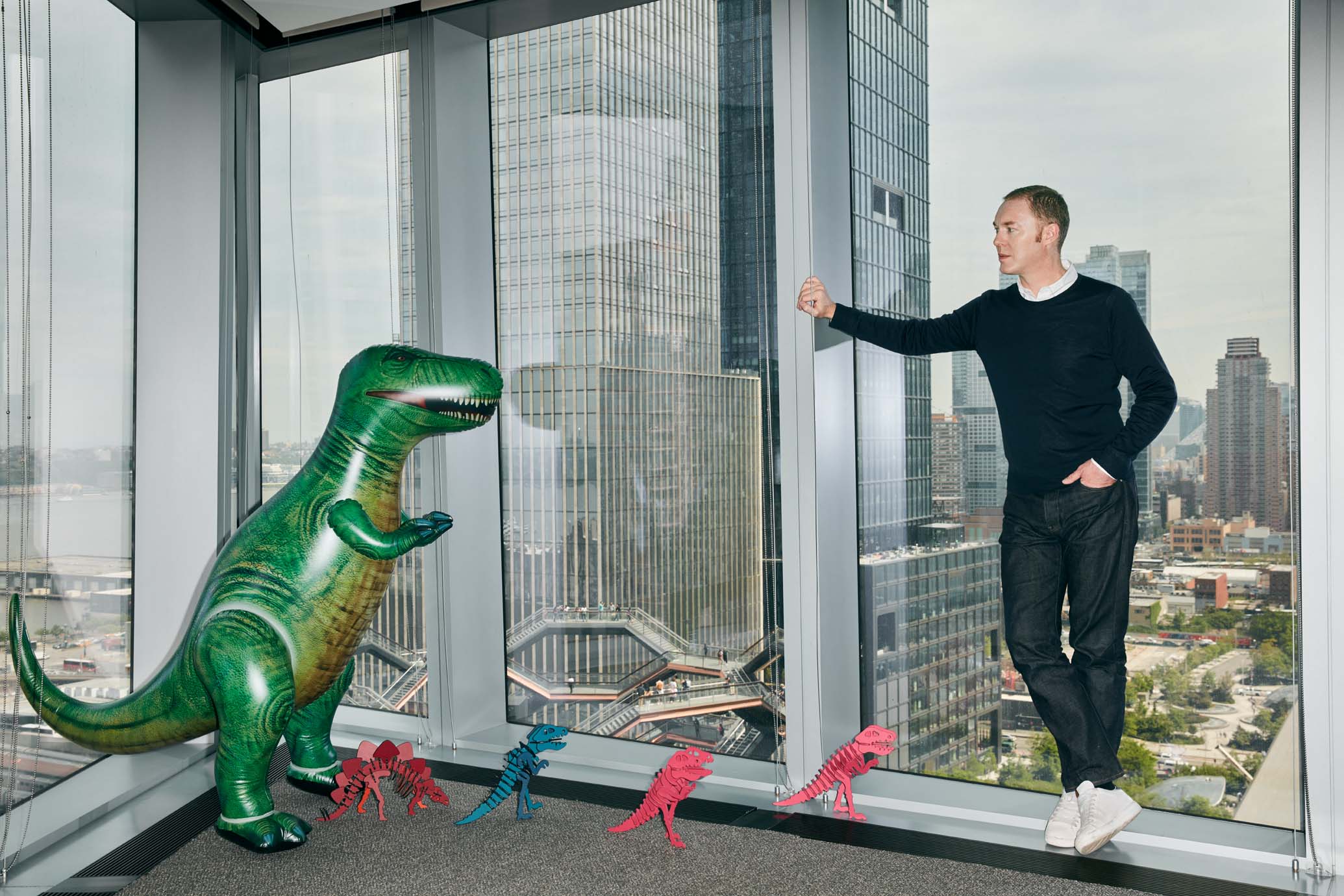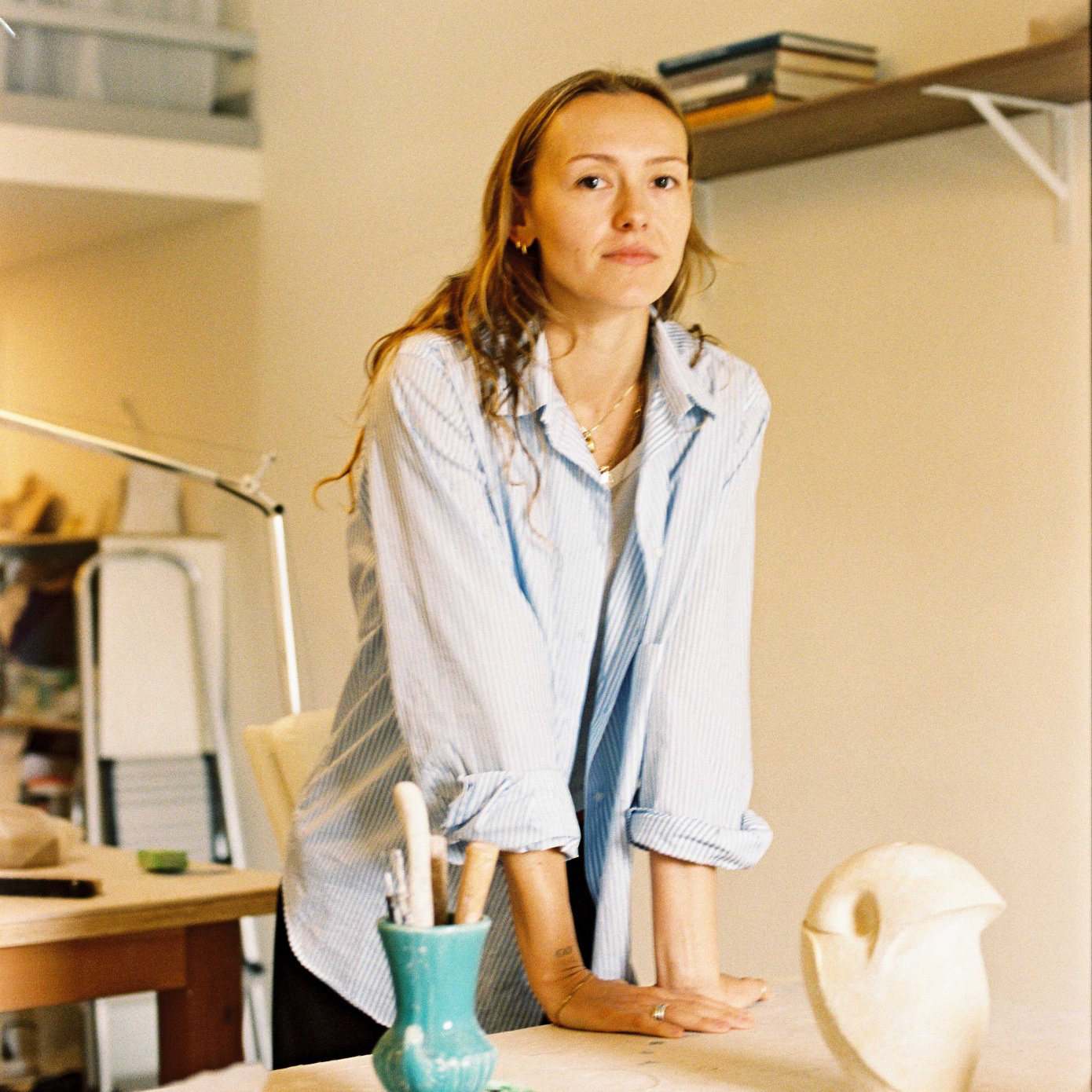
When Coach staged it's pre-fall 2019 runway show in Shanghai last December—a Times Square circa 1975 fantasia dropped into the hangar-like space of the West Bund Art & Design fair—it got a local assist. China has become one of the American heritage brand’s biggest markets, so for their first fashion show there, Coach creative director Stuart Vevers was wary of blowing into town, cowboy-style, all American bluster and cultural exceptionalism. Instead, he recruited a group of Shanghai-based artists: painter Zhu Jingyi, sculptor Sui Jianguo, street artist Guang Yu, and music collective Yeti Out, to interpret one of Coach’s newer and more playful brand codes—Rexy, a shapeshifting and high-performing tyrannosaurus. Rexy has been previously imagined as bag charms and a 12-foot Billie Achilleos sculpture made from approximately 400 Coach bags installed in the New York flagship. In Shanghai, she (everyone at Coach will correct you on this point) appeared as calligraphic ink drawings and graffiti prints on backpacks and belt bags. It was a canny expression of fashion’s fellowship with visual art—light and fizzy, but grounded in an understanding of regional pride and place.
Fashion and art have been lucrative bedfellows since around the turn of the millennium, when Marc Jacobs fused Stephen Sprouse’s punky graphic scrawl onto Louis Vuitton handbags. In the intervening years, runways have run wild with artist collaborations and limited edition capsule collections. Since Vevers was installed as creative director in 2013, he’s imbued Coach with his interest in visual art, less from an aggressive marketing position than as a source of unexpected joy, revitalizing the leather goods maker into a bona fide ready-to-wear behemoth along the way.
Unlike other houses, though, who have leaned on high-wattage collaborations with blue-chip artists like KAWS, Takashi Murakami, and Andy Warhol, Coach has aligned itself with quieter names in the art world, plucking far-flung talents and colliding them with the household perennials. Vevers’s choices in co-signs reflect his own eclectic taste—everything from Keith Haring to Peanuts—with a genuine sense of wonder and pleasure throughout. Vevers simply likes what he likes.
Vevers, who worked under Jacobs at Vuitton early in his career, took that example and made it his own. “Marc is really who I learned that from,” Vevers says from his 10th-floor office in Hudson Yards, a wall of windows overlooking the still undeveloped rail yards, a five-foot-tall inflatable Rexy standing sentinel in the corner. “I always found it really inspiring.” Vevers’s first collection for Coach was inspired by Joel Sternfeld’s large-format color photograph book American Prospects. At the runway show, a Sternfeld photograph of a suburban street made up the backdrop; the collection’s campaign made use of a 2000 Sternfeld image of an untamed High Line. For Spring 2015, he translated Gary Baseman’s creatures—cute, menacing, and pure id—to knit intarsia sweaters and gauzy sheath dresses. Vevers isn’t satisfied with having an artist’s work phoned in. He delights in the exchange. “With Gary, we had one of his images on the board for a kind of feeling, an attitude, and as we started to develop ideas around the collection, it was obvious that we were missing the true hand of the artist,” Vevers says. “It was at that point I realized we actually needed to connect with this person and create some real artwork together, and that’s what happened.” Vevers brought Baseman to New York from Los Angeles and gave him an office at Coach while they were developing the collection.
A similar story shaped last fall. Vevers, taken with “the idea of color” and perusing his home library, came across a book of Kaffe Fassett’s decorative art. “I immediately felt like I needed to speak to this person,” Vevers recalls. Their first conversation led to a full-fledged collaboration, with Vevers transmuting Fassett’s kaleidoscopic florals into swinging chiffon and needlepoint dresses suffused with a moody palette. “It often starts that way, with inspiration, and then it becomes more tangible.”
For Vevers, if a collaboration lands, it’s a credit to the process. “At times people can think there’s a strategy behind a lot of these things,” he says. “It’s all about finding something that inspires me and making a connection, trying to give people as much freedom as possible to do what they love.” To wit: the Shanghai pieces looked believably, almost premeditatively cohesive, but each artist received their prompt and were then allowed to go at it, only coming together at the show. “It was a cool moment,” Vevers acknowledges, smiling.
Vevers collects, but not in the bloodless, market-driven way that has become a New York pastime. “Most of the things I have around my home are from people I’ve worked with, or often because I was already a fan,” he explains. “I’ve got one of Andy Warhol’s little shoe sketches. A photograph by Nigel Shafran, whom I’ve worked with previously. Julie Verhoeven—a lot of Julie Verhoeven; she actually taught me illustration at college. I don’t think you can get a better illustration teacher than Julie Verhoeven. I have an incredible Kaffe Fassett quilt, Charles Schulz’s illustrations. A lot of it is the things I’ve ended up working with, but I work with them because I already love them. It’s always something that’s personal.”




